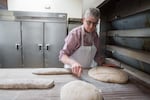
Ken Forkish of Ken's Artisan Bakery
Courtesy of Alan Weiner
You’re stuck at home. You’ve put hours in on Netflix. You’re talking to your cat. You’re talking to your plants.
What to do?
Go for the homiest of home kitchen crafts: bake some bread.
All-carb diets are the new low-carb diet. Scores of amateur chefs are leavening, kneading and baking their way through the coronavirus pandemic. The combination of anxiety and a surplus of hours in the kitchen have led to the Great Baking Boom of 2020. Grocery stores are running out of flour and yeast, and homes across the country are full with the unmistakable, comforting smell of homemade baked goods.
OPB "Weekend Edition" Host John Notarianni checked in with the man who wrote the book on home baking: Ken Forkish. He opened Ken's Artisan Bakery in Portland in 2001, and has branched out to run Ken's Artisan Pizza and Checkerboard Pizza. He's also a distinguished cookbook author, winning a prestigious James Beard Award for his 2012 cookbook, "Flour Water Salt Yeast: The Fundamentals of Artisan Bread and Pizza."
Here are a few tips from Portland’s Lord of the Levain:
Get the right flour
“Wheat, rye and barley flour all have gluten, but wheat has much stronger and a much higher quantity of gluten than the other grains. Right now, it’s not guaranteed you’re going to find the flour that you’re looking for. At minimum, if you can buy some form of whole-grain flour and some form of white flour, you’ll be able to make a starter and make bread at home.”
Stock up on yeast
"I recommend people buy one pound packages of yeast. Mostly you're going to buy it online. You can get it from King Arthur or Amazon; it can last you for a couple years. It will continue to perform well as long as you keep it in the refrigerator and keep it airtight."
Or, make your own levain (aka sourdough) starter
"Yeast is everywhere: it's in the air, in the soil and in the flour you buy (if you can buy it). You can create a natural levain starter pretty easily: It takes about six or seven days mixing flour and water in the right ratios and the right environment. I've spent the last week testing at home to figure out what the minimum amount of flour needed to get a viable sourdough starter. I put up a basic process this week on Twitter."
Mix your dough by hand
“The first couple times you do it you don’t have a point of reference, but once you’ve been doing it for awhile, having mixed it by hand, you will remember what it felt like on previous attempts. By that point, hopefully having had some success you’ll have confidence. The first time it’s a leap of faith–you just have to trust it.”
Before you bake, stick a finger in it
“Let’s say you’ve done everything: the loaf has been shaped, it’s sitting in it’s basket, your oven’s pretty heated. When is it ready to bake? You just poke your finger into the dough about a half inch, and then pull it back. Look and see: Does it spring back all the way? Does it stay completely deflated? If it springs back just a little, it’s perfect.”
Use the audio player above to hear the full conversation from OPB’s “Weekend Edition.”
